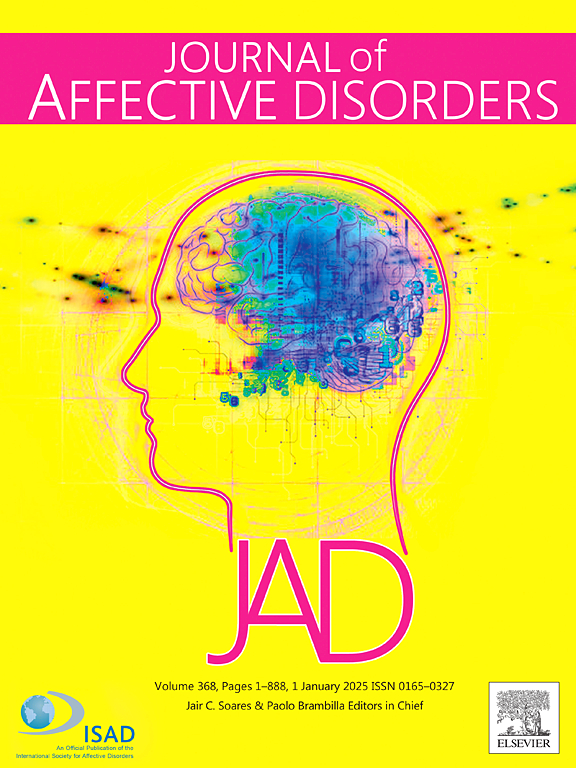E-health intervention for co-occurring at-risk alcohol use and depressive symptoms: Reach, adherence, and two-year effects of a randomized controlled trial
IF 4.9
2区 医学
Q1 CLINICAL NEUROLOGY
引用次数: 0
Abstract
Background
This randomized controlled trial explored reach, adherence, and two-year effects of a proactive e-health intervention for co-occurring at-risk alcohol use and depressive symptoms (ITE).
Methods
German medical care patients were screened for at-risk alcohol use and subthreshold depression. Over 6 months, ITE participants received 6 individualized feedback letters and weekly text messages. Primary outcome was change in a composite measure including problematic alcohol use (Alcohol Use Disorders Identification Test consumption questions) and depressive symptoms (two subscales of the Patient-Health-Questionnaire-8) from baseline to 6, 12, and 24 months. Analyses were adjusted for education, setting, major depression, and baseline differences.
Results
Among eligible patients invited, 51 % agreed to participate; 40 % completed the baseline interview and were randomized to ITE (n = 64) or assessment only (n = 68). Within ITE participants, 73 % received all intervention components. A latent change model revealed a small, insignificant impact of study group on the composite measure at 6 (d = −0.49, β = −0.41, p = 0.06) and 12 months (d = −0.26, β = −0.22, p = 0.35), diminishing at 24 months (d = −0.06, β = −0.04, p = 0.88). Secondary analyses showed a non-significant trend at 6 months, suggesting possible effect modification by baseline major depression (β = 0.80, p = 0.098), with larger effects in those without major depression.
Limitations
Self-reported outcomes; psychotherapy status unknown.
Discussion
ITE showed high adherence and overall small, although non-significant, intervention effects up to month 12. The potential effect moderation warrants further investigation in larger samples.
对高危饮酒和抑郁症状同时发生的电子卫生干预:一项随机对照试验的覆盖范围、依从性和两年效果
本随机对照试验探讨了积极的电子卫生干预对同时发生的高危酒精使用和抑郁症状(ITE)的影响范围、依从性和两年效果。方法对德国医疗保健患者进行高危酒精使用和阈下抑郁筛查。在6个月的时间里,ITE参与者收到了6封个性化的反馈信和每周的短信。主要结局是综合测量的变化,包括问题酒精使用(酒精使用障碍识别测试消费问题)和抑郁症状(患者健康问卷-8的两个亚量表)从基线到6、12和24个月。根据教育程度、环境、重度抑郁症和基线差异对分析进行了调整。结果被邀请的符合条件的患者中,51%同意参加;40%的患者完成了基线访谈,并被随机分为ITE组(n = 64)或仅接受评估组(n = 68)。在ITE参与者中,73%的人接受了所有干预成分。潜在变化模型显示,研究组在6个月(d = - 0.49, β = - 0.41, p = 0.06)和12个月(d = - 0.26, β = - 0.22, p = 0.35)时对综合测量的影响很小,不显著,在24个月时减弱(d = - 0.06, β = - 0.04, p = 0.88)。二次分析显示,6个月时无显著趋势,提示基线重度抑郁症可能改变疗效(β = 0.80, p = 0.098),无重度抑郁症患者的影响更大。LimitationsSelf-reported结果;心理治疗状况未知。ite显示高依从性和总体上小的,尽管不显著的干预效果,直到12个月。潜在的影响适度值得在更大的样本中进一步调查。
本文章由计算机程序翻译,如有差异,请以英文原文为准。
求助全文
约1分钟内获得全文
求助全文
来源期刊

Journal of affective disorders
医学-精神病学
CiteScore
10.90
自引率
6.10%
发文量
1319
审稿时长
9.3 weeks
期刊介绍:
The Journal of Affective Disorders publishes papers concerned with affective disorders in the widest sense: depression, mania, mood spectrum, emotions and personality, anxiety and stress. It is interdisciplinary and aims to bring together different approaches for a diverse readership. Top quality papers will be accepted dealing with any aspect of affective disorders, including neuroimaging, cognitive neurosciences, genetics, molecular biology, experimental and clinical neurosciences, pharmacology, neuroimmunoendocrinology, intervention and treatment trials.
 求助内容:
求助内容: 应助结果提醒方式:
应助结果提醒方式:


